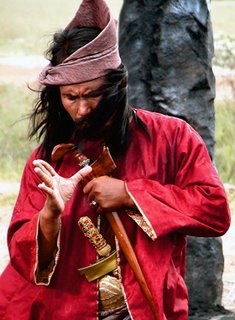How do you go about making a movie that has become the costliest ever in Malaysian film-making history? PHILIP GOLINGAI finds out from the director and producers of Puteri Gunung Ledang.
EPIC. Ambitious. Authentic. In the movie world, these words are dangerous. Dangerously expensive, that is.
But that was what Enfiniti Productions wanted when it decided to make a movie based on a popular local legend set in the 15th century. In order to come up with an epic that was ambitious and looked authentic, the company set aside RM7mil for its maiden effort.
When word got out, that princely sum – the biggest ever for a local production – stunned the industry and public. Many months later and poised for an August 26 release date in cinemas, Puteri Gunung Ledang (PGL) is indeed the most expensive movie ever made by a Malaysian production company. But it’s not a RM7mil movie but a RM15mil blockbuster.
That’s a lot of money when you consider that typically, a local movie costs only RM800,000 to RM2mil. Recent so-called big budget films – Embun and Paloh, costing about RM3.5mil each – were government-funded.
 RM15mil is also a staggering figure if you compared it to the total box office takings of all 10 Malay movies screened in 2002, which was about RM18.5mil.
RM15mil is also a staggering figure if you compared it to the total box office takings of all 10 Malay movies screened in 2002, which was about RM18.5mil. But that is the price of ambition. The prime movers behind PGL, executive producer Datuk Shazalli Ramly and producer Tiara Jacquelina, who also plays the central character, were determined to have a product that offered a fighting chance at winning international audiences too.
“We didn’t want to make a movie just for the locals. That is shiok sendiri (pleasing oneself). You will not go anywhere with it commercially. We need more eyeballs and Malaysia, with only 500,000 cinema-goers, would not be sufficient. We want to screen the movie world-wide,” says Shazalli.
Tiara Jacquelina adds: “It will pave the way for Malaysia to be on the world map of filmmaking.”
And the man they entrusted with the job of spending all that money to create that desired masterpiece is director Saw Teong Hin, who takes pains to point out that, hey, it wasn’t all that much if you compared it to Western-made blockbusters.
“RM15mil sounds like a lot of money. But given the film we were trying to make, it is not. Everybody just looked at the figure and said ‘Oh, so much money.’ But we had to achieve a lot with that RM15mil. Look at Troy – it costs about US$200mil (RM760mil) to make.
“A lot of people have jumped to hasty conclusions. If you use your common sense and think about – period drama, 15th century – it means you have to build your sets from scratch and create your own costumes and that takes money,” says Saw.
He insists confidently that movie-goers will understand and appreciate the level of technical expertise that went into PGL when it is released.
“It is equivalent to a standard Hollywood film which, regardless of whether you liked it or not, would have very high production quality and good sound and special effects.
“If you use that as a benchmark, (PGL) comes close to that. So at US$3.9mil (or RM15mil), to be able to do an epic drama is an amazing achievement. Because even an independent, small character-driven film in America would cost about US$5mil to US$10mil.”
Saw reveals that they strove to get the best they could for PGL: “We did live sound with no dubbing, we had actual construction of the sets, we did CG (computer graphic) in 2K resolution because most local movies using CG do it in (lower) TV resolution quality.
 For the sake of authenticity, director and producers refused to take shortcuts.
For the sake of authenticity, director and producers refused to take shortcuts. “We could have gone to the Malacca Museum (to film the palace scenes). But to the right, you would see electric poles and to the left were traffic lights.”
In the end, they built the set for a 15th century Malacca palace.
Says co-producer Mini Purushot: “The sets were important. We could not just go to a shopping complex and shoot a scene there. We were showing Malacca’s golden era. So the palace had to be big and grand.’’
The task of building the sets for the Malacca Palace, a Majapahit Palace and the princess’ hut was the responsibility of production designer Haznizar Ithnin. But the grandest set was Malacca town, which had not just the palace, but a village, harbour, mosque and bridge. The location was an open area measuring 300m by 450m in a oil palm estate near Batu Pahat, Johor.
To ensure authentic and accurate depiction of 15th century structures, Haznizar spent two months researching the architecture by poring over books and visiting museums.
Enfiniti Productions also had to recreate authentic clothing for three cultures of that time - Malaccan , Majapahit and Demak. That required extensive research and creativity, says costume designer Mahyuddin Sidik.
“For example, Sultan Mahmud Shah’s outfit was based on my reading of books such as Sejarah Melayu and (extrapolating from) the contemporary garments worn by the sultans today,” he explains.
To illustrate the difficulty of making an epic, Saw uses the example of the scene where the princess of Gunung Ledang, Gusti Putri Retno Dumilah played by Tiara Jacquelina, leaves Java for Malacca.
“It was really, really difficult to do the sailing shot because we had a barge out in the sea with the cast, crew and cameras. Your timing must be right as you could not dictate which way the waves were going. And because we were shooting off Pulau Perhentian, we could not anchor the barge on the coral reefs so everything was adrift. We needed many days for a shot that lasts only about 20 seconds on the screen.
“That is why many people don’t do this sort of thing because it is hard. But I wanted to take up the challenge. To the producers’ credit, they shared my vision. They could have easily said ‘Forget it’ and they would have saved time and money.’’
The script also required scale. ``There is nothing that can replace scale,” explains Saw. For example, to do a war scene you need a minimum number of people (referring to the battle between the warriors of the Demak and Majapahit Empires).
``In the planning stage, we cut down on the number of extras to what we thought would be sufficient. But when we went to the site, it was amazing how the people were swallowed up so quickly by the space. So we had to add more people so that it did not look cartoonish.’’
The filmmakers had to recruit extras on the spot by going to different villages and telling the penghulus that they were shooting a movie and needed people in the scenes.
Adds Purushot, “We used more than 500 extras and that meant providing them with costumes, food and an allowance.’’
The war scenes also required 100 horses and riders, not to mention 50 children, 30 cows, 50 goats and 50 chickens – a veritable zoo!
“We had burning houses and stunt men on fire with six cameras rolling at the same time,” recalls Saw with relish.
Foreign expertise was brought too and the international crew included B.G. Magendran, the art director who oversaw the set building carried out by his team of skilled builders and craftsmen from India; Jason Kwan, the director of photography from Hong Kong and Purushot who was a television producer for Sun TV and Surya TV in India.
The filming took cast and crew to several locations all over Peninsular Malaysia including Tasik Kenyir, Cameron Highlands, Lata Kijang waterfall in Perak, Sungai Kesang in Johor and Pulau Indah in Selangor.
This is also the first time a Southeast Asian movie used digital intermediate (DI) technology. “With DI, film is transferred into (computer) data and we do the corrections – colour grading and visual effects – in that format before transferring it into film,’’ explains Purushot.
Over 20 minutes of visual effects, totalling more than 200 shots, were used in the 155-minute movie. For example, when Hang Tuah (M. Nasir) searches for Gusti Putri Retno Dumilah, he follows a trail of seven butterflies which are computer-generated graphics inserted seamlessly into the scene.
For the music score, the production house used live instruments. “Of course we could have done it with a synthesizer.
It would have been cheaper but we wanted to go as high quality as we could,’’ says Saw.
The film, which was shot in 94 days during a nine-month period starting in January 2003, has all the proportions of an epic. But Saw is quick to point out that it is “huge” not just for the sake of merely looking impressive.
“It is huge in a functional way,’’ he says, adding “when you see the movie, you will be surprised that it only cost RM15mil.’’
Let’s hope it’ll be a pleasant surprise for Malaysians and the rest of the world.



